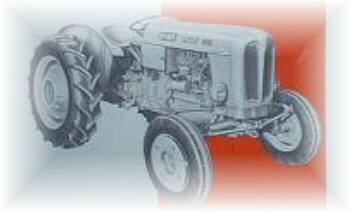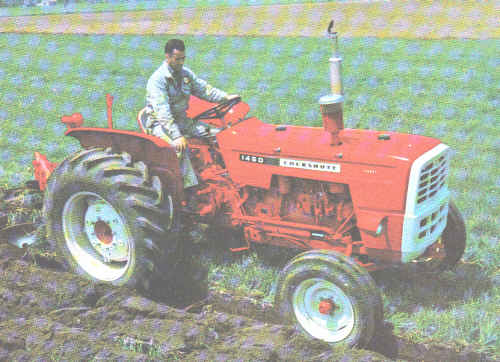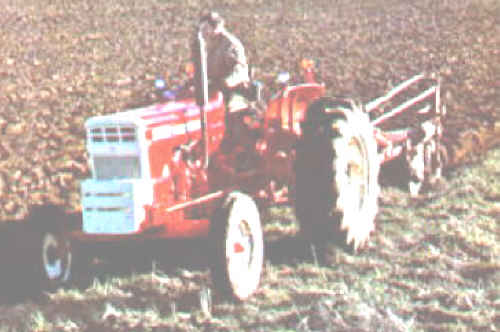The Fiat-Built Cockshutts

The Fiat 411R
For more modern, full-featured utility tractors in the late '50's, Cockshutt turned to Fiat of Italy for the Cockshutt 411R, and 411RG, four cylinder Diesel and Gasoline models, respectively, both rated at approximately 35 PTO Hp. In Fiat or Cockshutt form, the model numbers remained the same. These tractors were modestly popular.

The 1250
Following the 1962 sellout of Cockshutt to White Motor Company, from 1965 to 1967, White appeared content to continue importing the successor to the Fiat 411R & 411RG models, the 415, again in Diesel and Gas models. The model names as appearing on Cockshutt--and now Oliver--tractors, was 1250, in Gas and Diesel. The 1250 Gas was rated at 35 PTO HP, and the 1250 Diesel produced 38.5 PTO HP. Both ran at a high rpm of 2500. Mechanically much the same as the 411R/411RG tractors, they were restyled to a much more esthetically pleasing sheet metal design. Both Gas and Diesel models featured a modern, very versatile, dual range, single stick, 6 speed forward, 2 speed reverse, partially synchromeshed transmission, with a live PTO, controlled by a two stage clutch. 6th to 5th, and 3rd to 2nd gears were also synchromeshed, allowing easy downshifting to control loads. A heel-operated differential lock made control of a spinning wheel easy, and greatly increased traction while plowing muddy clay soil. Brakes were drum type, with external bands. Also included in the PTO package, was a ground speed PTO selection, handy for such things as raking or manure spreading, and also useful for unblocking a baler or harvester pickup by simply shifting into reverse and backing up, which reversed the PTO and the implement itself. A draft and position control 3 point hitch was standard equipment, and maximum lift was 2650 pounds, or an impressive 75% of overall tractor weight of 3510 pounds.
The Gas and Diesel models differed much in the area ahead of the instrument panel.
The Gas model nested it's engine between two frame rails, which
were themselves connected near the front by a sturdy support member
for the front axle, and across the very front by a lighter crossmember
that provided a tidy, finished look to the frame unit, while the
Diesel model utilized a 'stressed block'; that is, a chassis using
the engine's cylinder block as the connecting (and self-supporting)
unit between the transmission and the front axle.
The engine used in the 1250 Gas models was a 4 cylinder, 116 cubic inch, 3 main
bearing, OHV (OverHead Valve) engine. Compression ratio was 7.5:1. Bore and stroke
was 3¼ by a very short 3½ inches. The intake and exhaust manifolds were one on top of the other,
in common inline gas engine technology. The two manifolds were cast separately.
A Solex downdraft carburator was mounted on top of the intake manifold, and
connected to the oil bath air cleaner by a short 90 degree rubber hose. This
was a wet sleeve engine, and featured unusual, siamesed sleeves; two sets of two.
The pistons were 3 ring style. Also unusual in this engine was the fact that the
three main bearings were all different types and sizes. The crankshaft itself was
a lightweight unit. A cast iron oil pan added extra rigidity to the engine.
The Diesel engine was a 138.5 cubic inch, 4 cylinder, 5 main bearing,
dry sleeve unit. This engine used a very high 21.5:1 compression ratio.
Bore and stroke was 3 5/16 by 4 inches. The crankshaft was a heavier unit
than the one used in the Gas model. The Diesel engine crankshaft used two
different sized sets of main bearings; the front two sets were narrower than
the rear three sets. 4 ring pistons were used for better compression seal. A
heavy, intergrally braced oil pan increased overall engine unit rigidity.
Using Oliver and Cockshutt's Certified Horsepower program, the 1250 Gas
was Certified at 35 PTO horsepower, and the 1250 Diesel at 38.5 PTO horsepower.
Both engines were rated at high-for-the-era 2500 RPM.
The Gas and Diesel tractors used different front
axles and steering linkage assemblies, although certain parts,
such as front wheels and hubs, remained the same. Power steering
was an option. 1250 Diesel models were available in 4 wheel drive,
and in Orchard, Vineyard, and Extra High Clearance versions.
The 1250 Gas model wasn't available in all of these specialized
versions, however.
An innocent enough looking tractor, the 1250 was plagued
by gremlins, with it's orphan 24 volt electrical system in
particular. Engine problems abounded, especially in the Gas model,
which had been sourced as a military surplus engine.
It was accessorized by nearly impossible-to-find ignition and
induction parts. Sharing the 24 Volt electrical system, the
Diesel model addionally suffered from a seemingly insatiable
appetite for head gaskets, short life of rod and main bearings,
and, finally, the inclusion of a red-headed orphan child of an
injection pump. The parts supply for these two engines dwindled
rapidly, and both were very soon labeled "lemons" in the tractor
industry. It was a shame, as both tractors were very pleasant to
operate when in good running condition. Possessing a respectable
transmission and chassis design, a little more care in engine
design--or selection--could have left the 1250 tractors in an
enviable status for dependability, rather than a notorious one
for being fragile and finicky.
Today, 1250 Gas models often find themselves being re-powered,
usually in the form of an IH C153 combine engine, resulting in a
nice, reliable, nimble little tractor, with a ready parts supply.
1250 Diesel models seldomly are re-powered, being that repowering
a stressed block tractor is much more difficult than dropping a
replacement engine into a frame as in the 1250 Gas.

The 1450
Continuing with the sales success, at least, of the 1250, White began importing the Fiat 615, a heavy, sturdy, low profile, 1900RPM 4 cylinder tractor producing 55 HP at the PTO. As the 1450's Fiat 615 model was a 'big brother' to the 1250's Fiat 415, the styling of the 1450 was much the same as the 1250, including the 1250's fancy--and distinctively European style--Siem headlight units, outboard of the grille. 1450 models were available in 2 or 4 wheel drive versions, the latter with the same 'side drive' front wheel assist axle as the 1250. A single stick (with an outboard high/low lever) 7 speed forward, 2 speed reverse transmission, featuring disc brakes and an independant PTO, was a welcome feature for utility work, as was the standard power steering. Three point hitch lift capacity was an impressive 4400 pounds, or over two thirds of the tractor's overall 6000 pound weight--nearly double that of the 1250. The 1450 also optionally incorporated a 2 speed planetary power shift, known as "Ampli-Couple", which apparently didn't work out very well, as no Fiat-built Cockshutt tractors appeared after the 1450 with a power shift of any sort. Head gasket problems plagued the 1450 as well, with copious coolant leakage often being readily apparent along the left side of the cylinder block. The blackest cloud on the 1450's horizon was not the leaking of the head gasket itself, but rather the repair of it, as it's specially-tapered head studs tended to twist off during removal, and then had to be drilled out. A drill bit wandering off of the top of a hardened stud could--and often did--penetrate the 1450's thin water jacket, thus destroying the block. Many, if not most, of 1450's met their Waterloo this way. The Cockshutt 1450 was built from 1967 to 1969.
Back to the Drawing Board...

The 1250-A & 1255
The 1250, beginning as the Fiat 415, with it's inherant problems, underwent a major design overhaul, to become the Fiat 450, or the Cockshutt 1250-A. A Gas version was no longer available, and the Diesel engine was now a high compression 3 cylinder unit, of 143 cubic inches with a maximum governed speed of 2400RPM. The 3 cylinder engine was an adjustment for many farmers in the North American market. The front axle differed only slightly from the 1250 Diesel. The 6 speed forward, 2 speed reverse, locking differential transmission from the 1250 was retained (with a few minor upgrades), along with the live PTO, with it's two stage clutch design, although the clutch itself was now a much heavier unit. The 1250-A was produced only during part of 1969. Basically dropping a completely new engine in between the 1250's transmission and front axle resulted in a dramatically improved tractor. It was such an improvment that the entire sheet metal cladding of the tractor was given a restyling, also, possibly to hide the fact that it was mostly an engine swap that resulted in a "new" tractor model. It likely also helped separate the 1250-A from the 'black sheep' family status of the 1250.
Corresponding to the full line change from the '50 Series to the '55 Series, the 1250-A became the 1255, although no actual mechanical or styling changes accompanied the model number change. 1255 production continued for the remainder of the 1969 year, 1970, and 1971. The 1250-A/1255's were nearly bulletproof, sturdy little tractors, and dealers must have breathed a sigh of relief, as the 2 WD version in particular soon developed an excellent and enviable reputation for dependability and durability. In all versions, the 1250-A/1255 tractors produced a snappy 41 PTO HP.

The 1355
An extra cylinder was added to the Fiat 450's engine to become the Fiat 550, or the Cockshutt 1355. The 1355's 4 cylinder engine was a 190 cubic inch displacment unit. The 1355 also benefitted from a heavy crankshaft balancing unit, slung underneath the crank itself, and comprised of two counter-rotating rotors, similar to those used in a gear driven supercharger. Available in two and four wheel drive versions, the 1355 produced 51 Certified PTO HP, through a new 2 stick, dual range, 8 speed, partial synchromesh transmission, with an independant PTO with a ground speed selection. 8th to 7th, and 4th to 3rd gears were synchromeshed, allowing for easy downshifting. A differential lock gave better traction in tough going. Brakes were of the same design as the 1250/1250-A/1255 tractors, but with slightly wider drums and bands. The two wheel drive tractors used a new, rugged, inverted 'U' front axle center member, designed from the start for loader work. This tractor very abley replaced the 1450 with a much more durable powerplant, one more ground speed, plus ground drive PTO capability, and greater overall manueverability. It shared practically no parts interchangability whatsoever with it's predecessor, as it (the 1355) had undergone an even more intensive redesign over the 1450 than the 1250-A had over the 1250. The tough, peppy, dependable Cockshutt--and Oliver--1355 was built from 1969 until 1971.

The 1265 & 1365
The Fiat 450 and 550 tractors were updated and given new model designators overseas, to become the Fiat 480 and 640, and on this side of the pond, things were no different, with the new model 1265 and 1365 joining the Cockshutt stable. Retaining the same transmission and PTO specifications of the 1255 and 1355, the 1265/1365 tractors themselves manifested modest improvements, mostly in the increase of cylinder bore from 95 millimeters to 100, and a changeover in early production from 6 bolt crankshafts to 7 bolt units. However, in a much more dramatic--and welcome--improvement, the side drive front wheel assist front axle was discarded in favour of a centerline drive version, which incorporated outboard planetary final drives. The side drive front assist axle in the 1250, 1250-A, 1255, 1355, and 1450 tractors was a rather fragile unit, but the centerline drive in the new 1265 and 1365 tractors was an impressively robust one, finally up to the quality of the tractor driving it. Cockshutt now had a real pair of power stars in it's utility lineup. The 1265 developed 43 Certified PTO HP, while the 1365 increased this to 59 HP at the PTO. The 1265 and 1365 tractors were a smash hit for Cockshutt from 1971-1975, selling thousands, and are still well-respected chore and loader tractors today.

The 1465
Stepping into a heretofore non-existant design slot, and bringing back the prefix of "14", the 268 cubic inch Fiat 750 became the Cockshutt 1465, the largest utility tractor in Canada during it's production from 1973 to 1975. With it's longer wheelbase, larger rear wheels and tires, and, of course, it's 77 horsepower engine, the 1465 was really a dual purpose tractor, equally at home in the barnyard or the open field. Possessing a rather large increase in horsepower over the earlier 1450, single row harvesters were easy work for the 1465's 70 Certified PTO HP. It's 2100RPM engine was much improved over the 1450, and gave good service under daily usage. Using the same tough, basic 7 speed forward, 2 speed reverse transmission, with disc brakes and independant PTO as the 1450 tractor (the 1450 itself not being all bad), in it's front wheel assist version, the 1465 could take on the muddiest field pulling a harvester and a fully loaded forage wagon. Having a higher operator's position than the 1450--and perhaps indicative of things to come in the high horsepower utility market--the powerful 1465 signified something besides technological progress: it was to be the last Cockshutt tractor model ever to be introduced to the public, and also the last Cockshutt--or Oliver--tractor to be built by Fiat.
In all tractor models, the Cockshutt name was laid to rest in 1976, after an impressive run of nearly half a century.
Ok, so not quiite End of Story...
White's association with Fiat didn't die with Cockshutt or Oliver--it did continue. No, things certainly would never be the same, but nobody can stand in the way of that sometimes-ominous 8 letter word: "Progress"...
The Italian Connection Part II: Fiat-built Whites

Parts for Fiat-built Cockshutt Tractors







